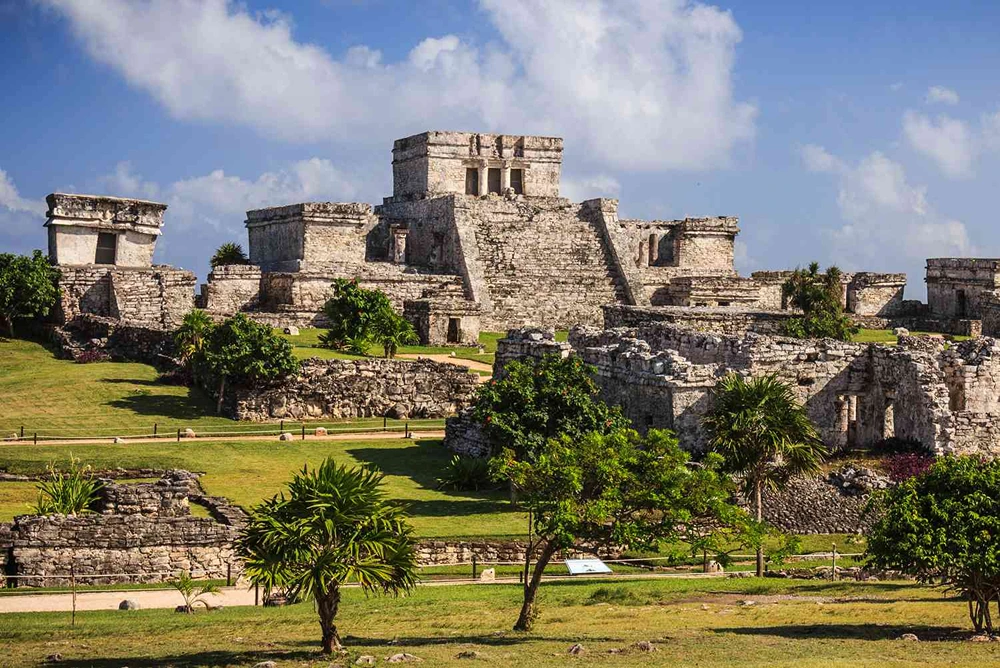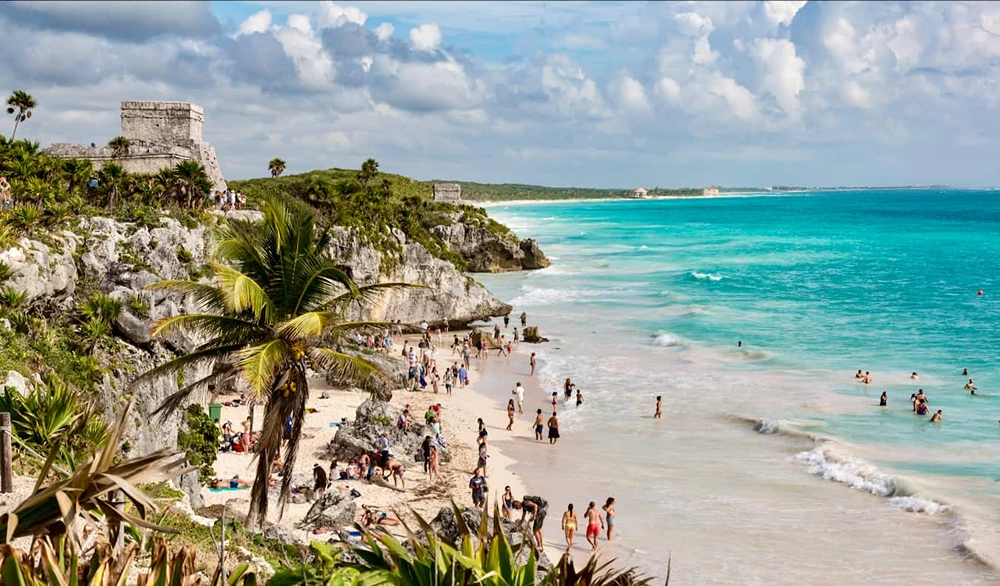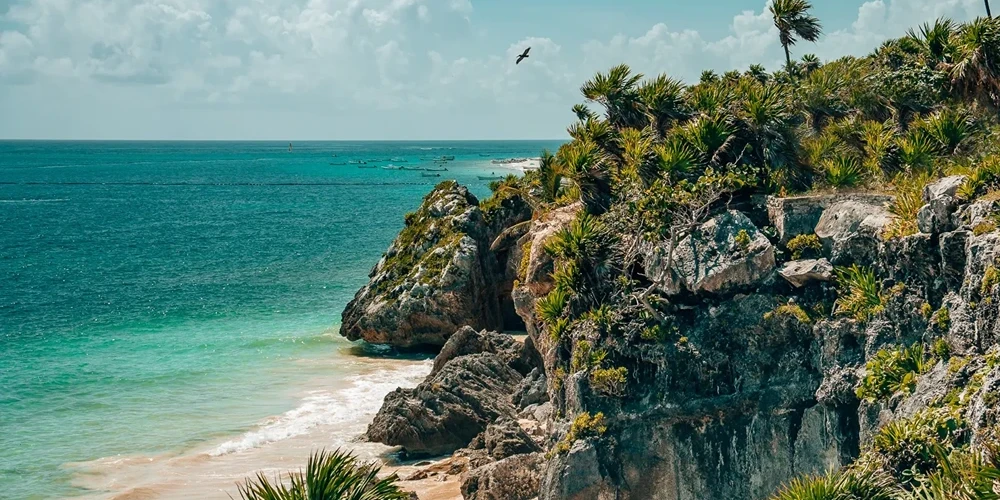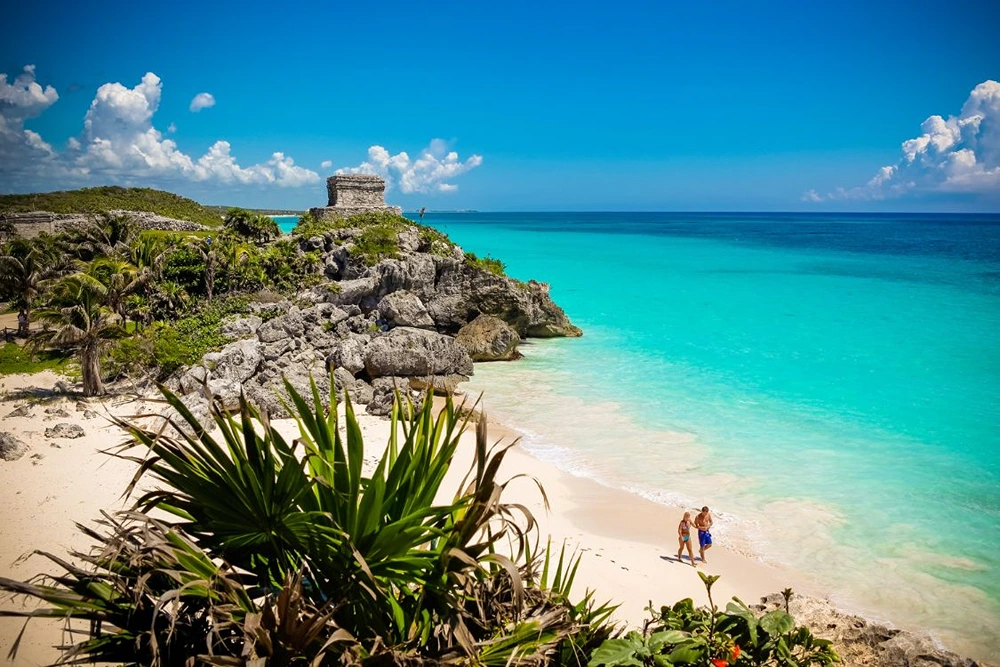Travel Resources
To help you plan your perfect trip to Tulum, here are some essential resources:
- Flights: Find affordable flights to Cancun International Airport (CUN), the nearest major airport to Tulum, using our flight search tool.
- Insurance: Secure comprehensive travel insurance to protect against unexpected events during your Tulum adventure.
- Car Rental: Book a rental car for flexibility in exploring Tulum and nearby attractions like cenotes and archaeological sites.
- Tours: Discover guided tours showcasing Tulum’s Mayan ruins, cenotes, and the Sian Ka’an Biosphere Reserve.
- Packing: Use our Tulum-specific packing checklist to ensure you’re prepared for beach activities and exploring ruins.

Key Highlights:
- Location: Situated on the Caribbean coast of the Yucatán Peninsula
- Population: Approximately 46,000 (as of 2020)
- Language: Spanish is the official language, but English is widely spoken in tourist areas
- Nickname: “The Jewel of the Riviera Maya”
Tulum has transformed from a quiet fishing village to a bohemian paradise, attracting travelers from around the world with its pristine beaches, ancient ruins, and commitment to sustainable tourism.
Some History First
Tulum’s history is deeply rooted in the ancient Mayan civilization and colonial influences.
Key Historical Points:
- Pre-Columbian Era: Tulum was an important Mayan city and trading port, flourishing between the 13th and 15th centuries
- 1518: First contact with Spanish explorers
- 16th-19th Centuries: Gradual decline of Mayan civilization and Spanish colonial influence
- Early 20th Century: Rediscovery and archaeological exploration of Tulum ruins
- 1970s-1980s: Beginning of tourism development in the area
- 2000s-Present: Rapid growth as an eco-chic tourist destination
Today, Tulum stands as a testament to its rich Mayan heritage while embracing sustainable tourism practices.
Tulum Today
Modern Tulum is a harmonious blend of ancient history, natural beauty, and eco-conscious living.
Notable Aspects of Contemporary Tulum:
- Eco-Tourism Hub: Known for its eco-friendly resorts and sustainable practices
- Wellness Destination: Home to numerous yoga retreats and holistic wellness centers
- Culinary Scene: Thriving food scene featuring local and international cuisine
- Art and Culture: Growing community of artists and artisans
- Conservation Efforts: Ongoing initiatives to protect local ecosystems and archaeological sites
Is Tulum Safe?
Tulum is generally considered safe for tourists, but as with any travel destination, it’s important to exercise caution.
Safety Tips:
- Be aware of your surroundings, especially at night
- Use official taxis or reputable ride-sharing services
- Safeguard your belongings on the beach and in crowded areas
- Stay hydrated and use sun protection to avoid heat-related illnesses
- Follow local guidelines for swimming and water activities
Emergency Services: Dial 911 for police, fire, or medical emergencies
Where is Tulum?
Tulum is strategically located on the Caribbean coast of Mexico’s Yucatán Peninsula.
Geographical Details:
- Coordinates:2114° N, 87.4654° W
- Area: Approximately 64 km² (25 sq mi)
- Terrain: Coastal lowlands with beaches, mangroves, and limestone bedrock
Nearby Attractions:
- Playa del Carmen: About 1 hour north
- Coba ruins: About 45 minutes inland
- Sian Ka’an Biosphere Reserve: Bordering Tulum to the south
- Cancun: About 2 hours north
Latest Articles
From The Area
What is the Best Time to Visit Tulum?
Tulum enjoys a tropical climate with distinct dry and rainy seasons.
Seasonal Considerations:
- Dry Season (November-April):
- Pros: Ideal weather, less rain, comfortable temperatures
- Cons: Peak tourist season, higher prices, crowded beaches
- Rainy Season (May-October):
- Pros: Fewer crowds, lower prices, lush vegetation
- Cons: Higher humidity, afternoon showers, potential for hurricanes
Best Time to Visit: For most travelers, the dry season (November-April) offers the best weather conditions. However, the shoulder months of April-May and October-November can offer a good balance of pleasant weather and fewer crowds.
Special Events:
- Tulum Food, Spirits & Wine Festival (November)
- Art With Me Festival (April)
- Tulum Vegan Fest (usually in January)
How to Get to Tulum & Around
Tulum is well-connected to major transportation hubs and offers various options for local transportation.
Getting to Tulum:
- By Air: Fly into Cancun International Airport (CUN), then take a shuttle, bus, or rental car to Tulum (about 1.5-2 hours)
- By Bus: ADO buses connect Tulum to major cities in the Yucatán Peninsula
- By Car: Rental cars are available at Cancun Airport or in Tulum town
Getting Around Tulum:
- Bicycles: Popular for short trips, many hotels offer rentals
- Taxis: Available throughout town and the beach zone
- Colectivos: Shared vans that run along the main highway
- Rental Cars: Useful for exploring nearby cenotes and ruins
- Walking: The town center is easily walkable
Tip: Renting a bicycle is an eco-friendly and convenient way to explore Tulum’s beach road and town center.
Things to Do in Tulum
Tulum offers a wealth of activities and attractions for nature lovers, history buffs, and beach enthusiasts.
Must-Visit Attractions:
- Tulum Ruins: Ancient Mayan city perched on coastal cliffs
- Tulum Beach: Pristine white sand beaches with turquoise waters
- Sian Ka’an Biosphere Reserve: UNESCO World Heritage site with diverse ecosystems
- Gran Cenote: Popular cenote for swimming and snorkeling
- Kaan Luum Lagoon: Stunning lagoon with varying shades of blue
Cultural Experiences:
- Mayan Clay Ceremonies: Traditional healing rituals
- Temazcal Ceremonies: Ancient Mayan sweat lodge experiences
- Local Markets: Shop for artisanal crafts and local products
- Cooking Classes: Learn to prepare traditional Yucatecan dishes
Outdoor Activities:
- Snorkeling and Diving: Explore coral reefs and underwater cenotes
- Kitesurfing and Paddleboarding: Popular water sports on Tulum’s beaches
- Yoga and Wellness: Numerous beachfront and jungle yoga studios
- Cycling: Bike tours through the Sian Ka’an reserve or to nearby cenotes
Where To Stay In Tulum
Tulum offers a range of accommodations to suit various preferences and budgets.
Popular Areas to Stay:
- Tulum Beach: Eco-chic resorts and beachfront cabanas
- Tulum Town: More affordable options with easy access to restaurants and shops
- Aldea Zama: Upscale residential area between the beach and town
Accommodation Types:
- Eco-friendly beach resorts
- Boutique hotels
- Vacation rentals and Airbnbs
- Budget-friendly hostels
- Glamping sites
Recommended Hotels:
- Kin Ha Tulum Hotel (Town)
- Howlita Tulum – Adult Only (Town)
- Hotel Tiki Tiki Tulum
- Villa Pescadores Tulum (Beach)
- The Highline Tulum
Tip: Book well in advance for high season (December-April), especially for beachfront properties.

What To Eat In Tulum
Tulum’s culinary scene is a delightful mix of traditional Yucatecan cuisine, fresh seafood, and international flavors.
Must-Try Dishes:
- Cochinita Pibil: Slow-roasted pork marinated in achiote
- Ceviche: Fresh seafood “cooked” in lime juice
- Tikin Xic: Mayan-style grilled fish
- Elotes: Grilled corn on the cob with cheese and chili
- Tacos al Pastor: Spit-grilled pork tacos
Popular Restaurants:
- Hartwood: Farm-to-table cuisine with daily changing menu
- Arca: Contemporary Mexican cuisine in a jungle setting
- Gitano: Mezcal bar and restaurant with bohemian vibes
- El Camello Jr.: Local favorite for fresh seafood
- Tulum Vegan Fest: For plant-based options
Tip: Don’t miss trying locally produced mezcal and craft beers from the Yucatán region.
Entry & Exit Requirements
Visitors to Tulum must comply with Mexican immigration regulations.
Key Requirements:
- Valid Passport: Required for all international visitors
- Tourist Card (FMM): Required for all visitors, usually provided on arrival
- Visa: Many nationalities (including USA, Canada, EU) can enter visa-free for up to 180 days
- Length of Stay: Typically up to 180 days for tourists
- Departure Tax: Often included in airfare, but check with your airline
Note: Always check the official Mexican government website or your country’s embassy for the most up-to-date information.
What To Pack For Your Trip
Tulum’s tropical climate and outdoor activities require specific packing considerations.
Essential Items:
- Lightweight, breathable clothing: For warm and humid weather
- Swimwear and beach essentials: Including reef-safe sunscreen
- Insect repellent: Especially important during rainy season
- Comfortable walking shoes: For exploring ruins and cenotes
- Reusable water bottle: To stay hydrated and reduce plastic waste
- Biodegradable toiletries: Many eco-resorts request these to protect the environment
- Light rain jacket or poncho: For unexpected showers
- Cash: Some smaller establishments don’t accept cards
Tip: Pack a dry bag for keeping electronics and valuables safe during beach trips or cenote visits.
Remember to check current local guidelines and restrictions before your trip, as they may affect your travel plans and experiences in Tulum. ¡Buen viaje!
FAQs
Tulum can be more expensive compared to other parts of Mexico due to its popularity among tourists. However, there are options for different budgets.
Mosquitoes can be present, especially during the rainy season. Use insect repellent and wear long sleeves and pants in the evenings.
Yes, Tulum is known for its beautiful beaches with calm waters suitable for swimming and snorkeling.



